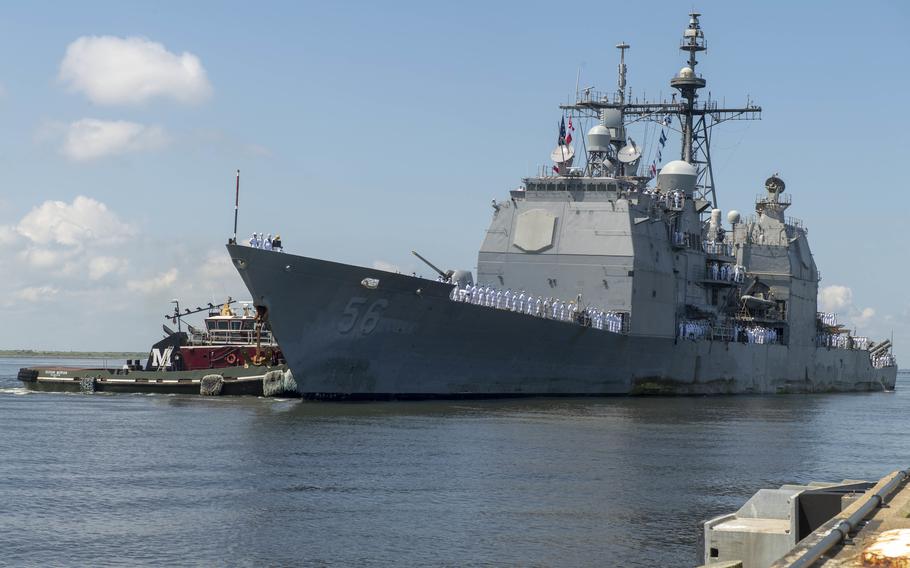
The Ticonderoga-class guided-missile cruiser USS San Jacinto (CG 56) returns to Naval Station Norfolk on Aug. 9, 2020, after a regularly scheduled deployment in support of maritime security operations and theater security cooperation efforts in U.S. 5th and 6th Fleet. (Colbey Livingston/U.S. Navy)
NORFOLK, Va. (Tribune News Service) — USS San Jacinto was tied up at Pier 6 on Naval Station Norfolk, with divers over the side to clean the ship’s bottom. Sailors in the cruiser’s blue-lit combat information center were thousands of miles away.
Like some 25,000 sailors and Marines, spread across 17 time zones, they were in the early days of a test of the Navy’s ability to fight a global war.
For San Jacinto, tied up at the pier but in a virtual sense off the coast of Norway, this meant the CIC team were in their usual role watching for enemy aircraft or missiles aiming at any of the warships in the USS Harry S. Truman carrier strike group.
“We’re actually monitoring any surface and air contacts. ... It could be anything from friendlies, people that we’re training with right now within this exercise, to simulated combatants, or unknown contacts,” said Petty Officer 2nd Class Matthew Falgoust.
The screens that he and the three tactical air controllers watch allow them to project tracks of aircraft and ships, using advanced software and their best judgment. The aim: to see which are threats and which are harmless.
Missing a threat puts one of the nation’s most potent weapons — the carrier Harry S. Truman and its air wing — out of commission. Seeing a threat when there is none could mean the nightmare of shooting down a civilian airliner, said Capt. Christopher Marvin, San Jacinto’s commanding officer.
Marvin is up these days at 4 a.m.
Though San Jacinto is, physically, tied up at Pier 6, with plenty of maintenance work in progress to monitor, it is attached to the 6th fleet, headquartered in Naples.
That morning briefing, among other things, lets him know how the more than 100 men and women in Norfolk’s Naval Warfare Development Command are running the two-week Large Scale Exercise, and revising its scenario, in response to decisions of sailors like Falgoust at points around the world.
And that gets to the heart of the Navy’s Large Scale Exercise. Like all military exercises, its purpose is to build muscle memory.
In this case, for officers at the highest level of the Navy and Marine Corps — the three- and four-star admirals and generals who, in this case, operate from the far western Pacific to the Caribbean to the North Sea.
A big part of that involves knowing how to respond to the daily challenges of uncertainty and judgment that sailors like Falgoust and Marvin deal with every day.
When a CIC team is pretty sure, but not absolutely sure, if one of the dots or lines on its screens is a threat, that poses a different kind of challenge farther up the line — especially when, as is the case in what is still the early days of the Large Scale Exercise, international tensions are high and nobody knows for sure when, if or where an adversary able to operate anywhere in the world might strike.
Communications glitches might force San Jacinto’s sailors or the staff at 6th fleet — or even Fleet Forces Command back in Norfolk or the Secretary of Defense — to scramble to make sure word gets through. That’s another muscle memory to be exercised.
“Our job is to reduce the fog of war,” Marvin said.
The exercise also will test how higher levels of command — fleets and joint operations — use new warfighting concepts the Navy and Marine Corps have been testing for the past few years.
These include a focus on using small, dispersed land and sea units to secure sea and air lines of communications as well as moving small units of Marines by sea for quick onshore attacks or intelligence missions.
The Large Scale Exercise includes the commanding admirals and staff of Norfolk’s 2nd Fleet, as well as the 6th Fleet in European and African waters, the 3rd and 7th fleets in the Pacific, the 4th Fleet in the Caribbean and South American waters and the 10th Fleet, the cyber command. Three Marine Expeditionary Forces, headquartered in North Carolina, California and Okinawa, five carrier strike groups, four amphibious groups and 24 task forces are participating.
So, another muscle to exercise, said Rear Adm. Doug Beal, exercise director, is for the Navy’s several fleets, their commanders and staff, to synchronize operations.
That can include operating side by side or moving ships and Marines rapidly and seamlessly from one command to another.
“For example, we have fleets going, ‘Hey, I know you have this. I have that I really have the warfighting requirement, how can we make this happen?’” said Ron Keter, another member of the exercise leadership group
“And then at least when they go up the chain, they have a coordinated response, which is what we’re trying to have them exercise.,” he said.
It isn’t always the easiest muscle to exercise, Beal interjected.
“Anybody that grew up with siblings understands this dynamic,” he said.
©2021 Daily Press.
Visit dailypress.com.
Distributed by Tribune Content Agency, LLC.